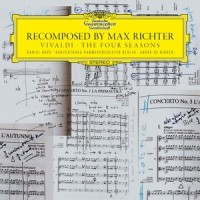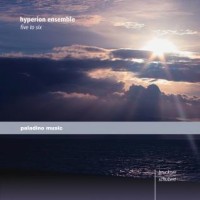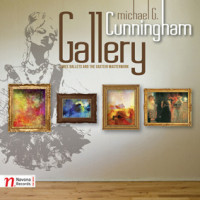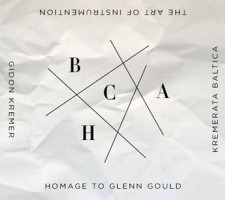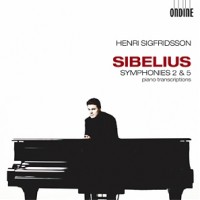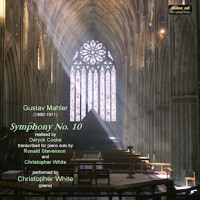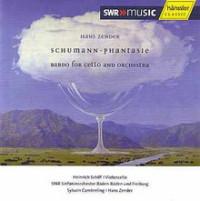(Dis)Arrangements
|
Grant Chu Covell [August 2013.]
“Recomposed by Max Richter.” Antonio VIVALDI: The Four Seasons (1723; recomp. Max RICHTER, 2012). Daniel Hope (vln), Konzerthaus Kammerorchester Berlin, André de Ridder (cond.). B0017448602 (1 CD) (http://www.deutschegrammophon.com/). I do like what Richter has done. No grousing that Vivaldi was the premier minimalist. The Four Seasons has been deftly mutilated. Richter estimates that 75% of the original was cauterized. Unimportant passages become repeated while others find different harmony among new rhythms. The results are distinctive, frequently jarring and unpredictable, ever energetic. Richter never forgets that harmony lies at Vivaldi’s core, regardless of repetition or the solo line. I imagine that Hope must hereafter worry he might confuse one for the other in performance. The Konzerthaus Kammerorchester with harp is vibrant. Some electronic washes lurk beneath: Spring opens with a taped prelude, and elsewhere the harpsichord imitates that mid-’70s plummy Pop sound. In the same series, DG offers “Recomposed by Matthew Herbert: Mahler Symphony X” and others which seem impossible to find on these shores. As another happy touch, the cover bears DG’s classic yellow escutcheon.
“Five to Six.” Anton BRUCKNER: Quintet for two violins, two violas and violoncello (1878-79). Franz SCHUBERT: Fantasie, D. 940 (1828; arr. Firmian LERMER). Hyperion Ensemble: Klara Flieder, Werner Neugebauer (vlns), Firmian Lermer, Peter Langgartner (vlas), Detlef Mielke, Erich Oskar Huetter (vlcs). Paladino MPR 0021 (1 CD) (http://www.paladino.at/). String players generally do not appreciate Bruckner. Perhaps they’re unwilling to imitate a lofty organ, or perhaps they don’t like the perplexing vacillation between repetitive rambling and insistent closure. Ironically, the Quintet may be one of his best constructions. The Hyperion Ensemble proceeds cleanly and neatly, without the true-blue Brucknerites’ tendency to swoon. Perhaps the Hyperion struggled between symphonic boldness and salon intimacy. Recasting Schubert’s four-hand piano Fantasy for string sextet seems reasonable. Unfortunately, Lermer’s literal transcription comes off as constricted. The original’s textural variety (stark chords, rolling accompaniment, ideas introduced in specific registers, interplay between the pianists’ hands, et al.) vanishes into overzealous bow strokes. More pizzicato and invented filigree might have brought more interest to this starchy effort. There’s a particularly beautiful moment in the piano original when the argument drops gently into the major. Here its pungency vanishes amongst strings. A note on the release’s clever title: Bruckner worked on the Quintet between his Fifth and Sixth and the ensemble expands from five to six players.
“Gallery.” Michael G. CUNNINGHAM: Nyadina (2006)1; She (2006)2; Chrysalis at Mardi Gras (2008)3. Franz SCHUBERT: Piano Sonata, D. 850 (1825; arr. Michael CUNNINGHAM, as Gastein Masterwork, 2007)4. Prague Radio Orchestra1, Robert Ian Winstin1 (cond.), Moravian Philharmonic Orchestra2,4, Petr Vronský2,4 (cond.), St. Petersburg State Symphony Orchestra3, Vladimir Lande3 (cond.). Navona Records NV5893 (1 enhanced CD) (http://www.navonarecords.com/). I may approach new releases cold, ignoring program notes and diving right into the music. This release brought on double-takes as these Cunningham pieces are less modern than works heard before. Nyadina is clearly the effort of a European orchestra, in this case, the Prague Radio Orchestra. I wonder if the air over there makes a difference in that I detect a specific brittleness. Regardless, content and style recall mid-century Supraphon or Louisville Symphony LPs. Cunningham’s dispenses conventional Schubert. A pianist taking the first movement as slowly (11:48) would be hounded off the bench. As in the ballets, we find textbook instrumentation: melodies supported by accompaniment, and trumpets doubling strings for emphasis. The second moment permits solos including unexpected flute embellishments. Repeated chords in the second movement sound like a fumbling Bruckner Jr. As a piano sonata, this music is complete. When transcribed, everything feels like a preparatory sketch. Even had it meant breaking away from the original, something rather more exotic would have been better.
Timo ANDRES: Home Stretch (2008); Mozart “Coronation” Concerto Re-Composition (2010); Paraphrase on Themes of Brian Eno (2010). Timo Andres (pno), Metropolis Ensemble, Andrew Cyr (cond.). Nonesuch 534416 (1 CD) (http://www.nonesuch.com/). I passed on Andres’ debut two-piano release, Shy and Mighty (Nonesuch 522413, featuring the composer with David Kaplan). Loosely minimal and improvisatory, it was too much furtive mumbling in an overcrowded room. The re-composition of Mozart’s Coronation Concerto infuriates. Andres’ industrious completion of the piano part (in many places Mozart only notated one hand, sometimes nothing) produces excessive notes and indistinct tonality. The outer movements proceed strangely as the expected harmony evaporates beneath clusters and other misdirections. The central slow movement is unforgivable. Because Mozart’s thin, naïve lines are so rooted to their default tonality, any wrong-note garnishing sounds stupid. Like the backup orchestra for a televised awards show, the Metropolis Ensemble’s aggressiveness doesn’t help. Take away Mozart as in Andres’ cadenzas, the remainder is aimless. I had hoped for a fresh view into the Mozart, maybe some pianistic wit with sly Liszt quotations or fun à la Spike Jones. Actually, anything with personality would have been fine. Home Stretch offers a thin broth for solo piano and chamber orchestra. The piano thumbs through a minimalist’s dictionary of startup effects, all of which wither. I couldn’t endure the Eno paraphrase. There’s no music here, and I’m not referring to Cage’s inclusive view of sound.
“The Art of Instrumentation: Homage to Glenn Gould.” Var comps. Kremerata Baltica, Gidon Kremer (vln, cond.). Nonesuch 528982. (1 CD) (http://www.nonesuch.com/). Kremer takes rewarding liberties. Here is Bach transplanted to the Baltic States drizzled with post-Romantic icing. Perhaps the nod to Glenn Gould permits rule breaking. I grew up with Gould’s Bach and it took decades of (re)listening before I could hear the pianist’s mannered carapace. These pieces permit Kremer and his string troupe plus percussion and a few winds to blur through Bach homages (Valentin Silvestrov, Giya Kancheli) and arrangements (Georgs Pelecis, Alexander Raskatov, Alexander Wustin, Carl Vine, Raminta Serksnyte, Leonid Desyatnikov, Victoria Vita Poleva, Stevan Kovacs Tickmayer). The Goldberg orchestrations (Pelecis, Tickmayer, Kissine) are the most interesting, whereas the WTC’s preludes and fugues (Raskatov, Serksnyte, Poleva) don’t improve when gussied up. Tickmeyer permits bits of Schoenberg’s Op. 19 and the Phantasy, Op. 47, to intrude. Everything here is opposite to Webern’s crystalline Musical Offering.
Jean SIBELIUS: Symphony No. 2, Op. 43 (1902; arr. Henri SIGFRIDSSON, 2011); Symphony No. 5, Op. 82 (1915-19; arr. Karl EKMAN, 1922; rev. Henri SIGFRIDSSON). Henri Sigfridsson (pno). Ondine ODE 1179-2 (1 CD) (http://www.ondine.net/). Even as Sigfridsson channels an orchestra, hearing these symphonies on piano is still strange. No. 2’s modern harmonies and Romantic twists emerge more forcefully. The third movement feels more like a Scherzo, its delineation from the Finale, more acute. While the Second could be piano repertoire, the Fifth is a harder sell perhaps because a non-sustaining instrument can’t be faithful to the innovative original. I’m constantly doing mental gymnastics, reconciling the piano presentation with my orchestral image. The last movement is problematic. Given chords’ inherent decay, the final bolts fail to surprise. I’ll take the Fifth in its original. This Second is worth revisiting.
Gustav MAHLER: Symphony No. 10 (1910; compl. Deryck COOKE, 1960-76; trans. Ronald STEVENSON, 1986, rev. 2001; Christopher WHITE, 2010). Christopher White (pno). Divine Art DDA25079 (1 CD) (http://www.divine-art.co.uk/). No stranger to grandeur, Stevenson transcribed Mahler’s Adagio, and newcomer White took on the remaining four movements as sorted out by Cooke. He has the orchestra in mind as he traverses the keys. Moments in the Adagio suggest a distorted waltz recalling the parallelism between the two versions of Ravel’s La Valse. Elsewhere, gaps and sutures loom more prominently. Now and again, especially in the second Scherzo, a note will pop as if completely wrong. I hear clusters which I suspect wouldn’t have made Mahler’s final cut. Perhaps White emphasizes them for effect. Unfortunately, the recording lacks mid- and lower-range heft. It disappoints that technology has failed White’s difficult task. The Finale’s imitation bass drum crashes are an absolute failure. Nonetheless, the concluding bars are pungently bittersweet.
Hans ZENDER: Schumann-Phantasie (1997)1; Bardo (1999-2000)2. Heinrich Schiff2 (vlc), SWR Sinfonieorchester Baden-Baden und Freiburg, Sylvain Cambreling1, Hans Zender2 (cond.). Hänssler Classic 93.128 (1 CD) (http://www.haenssler-classic.de/). Given that Zender’s Winterreise was a big hit, I approached his Schumann orchestration with high hopes. One’s mood needs to be right to appreciate the xylophone and timpani touches and short interrupting bits (a Prelude and two Interludes). The original sprawling Phantasie demands much from both pianists and listeners. Zender’s orchestration illuminates Schumann unnaturally. While it’s unreasonable to expect Winterreise II, Zender’s effort fails to engage on its own terms. Bardo is a multi-sectional cello concerto. Five solo movements alternate with five tuttis. The title refers to the Tibetan concept of “between” and alludes to the Tibetan Book of the Dead (“Bardo Thodol”). Cello microtones and mistuned piano swim with kitchen-sink orchestral outbursts. Together the orchestrated Phantasy and cello concerto pose a puzzle. Perhaps they chronicle a search.
Andres, Bach, Bruckner, Cooke, Cunningham, Desyatnikov, Ekman, Kancheli, Lermer, Mahler, Mozart, Pelecis, Poleva, Raskatov, Richter, Schubert, Schumann, Serksnyte, Sibelius, Sigfridsson, Silvestrov, Stevenson, Tickmayer, Vine, Vivaldi, Wustin, Zender
[More (Dis)Arrangements, Grant Chu Covell]
[More
Andres, Bach, Bruckner, Cooke, Cunningham, Desyatnikov, Ekman, Kancheli, Lermer, Mahler, Mozart, Pelecis, Poleva, Raskatov, Richter, Schubert, Schumann, Serksnyte, Sibelius, Sigfridsson, Silvestrov, Stevenson, Tickmayer, Vine, Vivaldi, Wustin, Zender]
[Previous Article:
Duodenal Etiquette, Scènes de Ballet]
[Next Article:
Seven Last Words, seven quartets]
|
